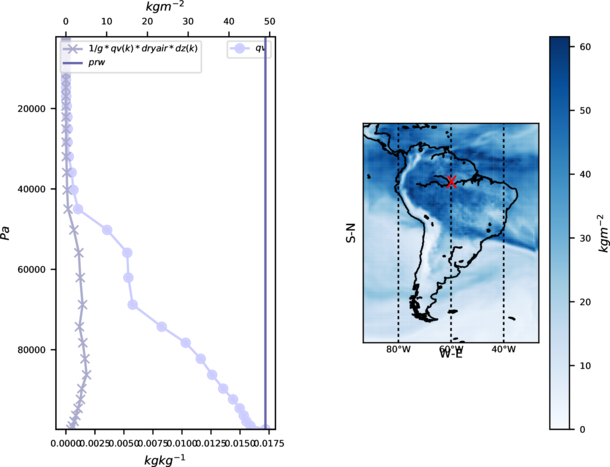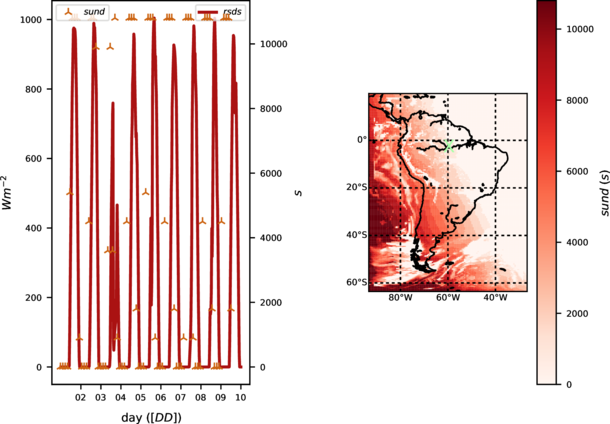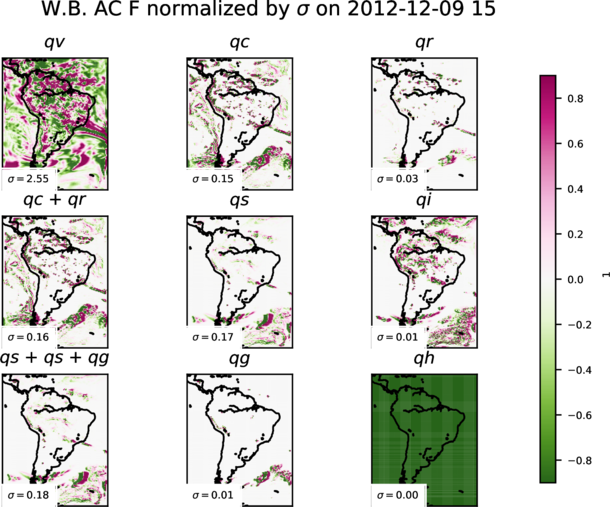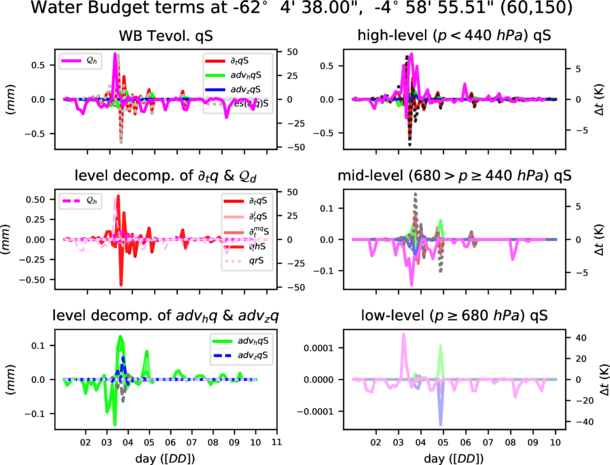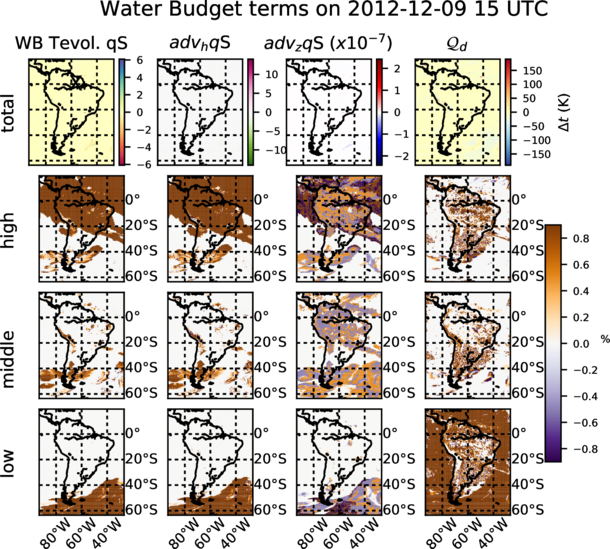CDXWRF
(→wsgsmax: Maximum Near-Surface Wind Speed of Gust) |
(→wsgsmax: Maximum Near-Surface Wind Speed of Gust) |
||
| Línea 262: | Línea 262: | ||
[[File:module_CORDEX_WRF0x.png]] |
[[File:module_CORDEX_WRF0x.png]] |
||
* <CODE>WRF_afwa_diagnostics:</CODE> Inside the WRF module <CODE>module_diag_afwa.F</CODE> there is an implementation of the calculation of the wind gust which only occurrs as a blending of upper-level winds (around 1km above ground zagl; -1 zagl(k1000 ) ≥ 1000 m, see equation 2) above a given maximum precipitation inrensity of pratemm_hr ≥ 50 mm [wsgs_diag = 2] |
* <CODE>WRF_afwa_diagnostics:</CODE> Inside the WRF module <CODE>module_diag_afwa.F</CODE> there is an implementation of the calculation of the wind gust which only occurrs as a blending of upper-level winds (around 1km above ground zagl; -1 zagl(k1000 ) ≥ 1000 m, see equation 2) above a given maximum precipitation inrensity of pratemm_hr ≥ 50 mm [wsgs_diag = 2] |
||
| − | + | [[File:module_CORDEX_WRF1x.png]] |
|
These two methodologies have been implemented and can be switched by a new <CODE>namelist.input</CODE> parameter labeled wsgs_diag (in cordex section). Its default value is 1 It comes out, that both methodologies provide wind gust estimation (WGE) from two different perspectives: mechanic and convective. In order to take into account both winds gusts, another variable as the addition of both estimations is provided as <CODE>totwsgsmax</CODE>, <CODE>totugsmax</CODE>, <CODE>totvgsmax</CODE>, <CODE>totwsgspercen</CODE>. On figure 2 is shown the different outcomes applying each approximation |
These two methodologies have been implemented and can be switched by a new <CODE>namelist.input</CODE> parameter labeled wsgs_diag (in cordex section). Its default value is 1 It comes out, that both methodologies provide wind gust estimation (WGE) from two different perspectives: mechanic and convective. In order to take into account both winds gusts, another variable as the addition of both estimations is provided as <CODE>totwsgsmax</CODE>, <CODE>totugsmax</CODE>, <CODE>totvgsmax</CODE>, <CODE>totwsgspercen</CODE>. On figure 2 is shown the different outcomes applying each approximation |
||
Revisión de 16:48 23 mar 2018
CDXWRF: WRF module for CORDEX
CORDEX requirements of data for stake holders and decision making community, push the output of the atmospheric models, which demands that usually require time consuming post-process of the standard model output. In order to avoid this time and effort consuming post-processing task, here is presented the implementation of a new module into the Weather and Forecasting Model (WRF, Skamarok et al. 2008) module called module_diag_cordex with which is expected to substantially limit the need of post-processing.
PDF version of this page here Archivo:module CORDEX WRF.pdf
In order to get the code send an email to : lluis.fita [a] cima.fcen.uba.ar in order to keep a track and being able to inform of new versions/corrections.
CORDEX requirements
CORDEX requirements of data must cover all the possible needs of stake holders, and scientists working on the adaptation and mitigation strategies. They are grouped in different levels of frequency and priority. A working copy of this list is available here from the CORDEX convection permitting Flag Ship Pilot study.
Some of the variables are not directly computed in the WRF model which require to extend the model output in order to provide enough variables to post-process the variables.
The implementation of the module_diag_cordex module should allow to avoid the post-processing by computing the CORDEX-required (Core & Tier) variables during model integration
NOTE:
Be aware that any systematic checking process has been applied to this module. Use it and the variables therein at your own risk !! It has been tested on a 2-nested domain configuration with the inner domain at cloud resolving resolution (< 5 km, without cumulus scheme), making use of restarts and on pure distributed memory parallel environment
module_diag_cordex
The module is basically based on two modules:
-
phys/module_diag_cordex.F: Main module which manages the calls to the variables and the accumulations for the means, ... -
phys/module_diagvar_cordex.F: Module with the computation of all the variables
This module is accompanied with a new Registry/registry.cordex where the variables and a new section
in the namelist.inpt labeled cordex are defined. There are other necessary complementary modifications on
phys/module_diagnostics_driver.F encompassed by the pre-compilaton flag CORDEXDIAG, as well some modifications in the main/depend.common and phys/Makefile.
Output is provided by the auxiliary history output #9 with a provisional file name: wrfcordex_d<domain>_<date>
All that variables which are only required at output time step, are computed only at that exact time.
Additional: pressure levels interpolation
At the same time, WRF can output on pressure levels while integration. However, initial version of the module does
not include required CORDEX variables: wa (vertical wind speed) and hus (specific humidity). Thus, code has also been modified and now, WRF output at pressure levels also provides wa and hus.
It has been accomplished after modifying the codes: Registry/registry.diags, phys/module_diagnostics_driver.F, phys/module_diag_pld.F and dyn_em/start_em.F. The three latest modifications are also encapsulated within precompilation flag CORDEXDIAG.
See more details in how to activate this option in WRF_users web-page over the namelist section diags&.
Additional: water budget
It has been added also the components of the atmospheric water budget. They are accumulated internally and vertically
integrated allover the column. In order to provide this capability, a series of modifications have been introduced in
dyn_em/solve_em.F
Installation
These steps must be followed prior the re-compilation of the WRF model and assuming that the process is started where the code resides (WRFV3)
- Untar the file
$ tar xvfz WRF_CORDEX.tar.gz
- It deflates all the required files and the modified orignal WRF files
main/depend.common dyn_em/solve_em.F dyn_em/start_em.F phys/module_diagnostics_driver.F phys/module_diag_cordex.F phys/module_diagvar_cordex.F phys/module_diag_pld.F phys/Makefile README.cordex Registry/registry.cordex Registry/registry.diags
- On the
Registry/Registry.EMadd the following line (after the line with includeregistry.new3d_wif)
include registry.cordex
- Clean the code (in order to avoid to run again configure one can make a copy of the
configure.wrfand recover it after the clean, otherwise it is erased)
$ cp configure.wrf configure.cordex.wrf $ ./clean -a $ cp configure.cordex.wrf configure.wrf
- edit the
`configure.wrf'and add the line (after the line-DNETCDF)
-DCORDEXDIAG
- compile as always
$ ./compile em_real >& compile.log
Usage
These are the steps to use the module
- One need to add to the
'namelist.input'the auxiliar output number 9 (e.g. for output every 3 hours and 1-day files) at the`&history'section:
auxhist9_outname = "wrfcdx_d<domain>_<date>" auxhist9_interval = 180, 180, frames_per_auxhist9 = 8, 8, io_form_auxhist9 = 2
- Also a new section should be added (assuming it will get complex and different implementations of the diagnostics might be necessary...)
&cordex
output_cordex = 1
psl_diag = 1: sea-level pressure diagnostic following hydrostatic Shuell correction
= 2: psl diagnostic following a target pressure
= 3: psl diagnostic following ECMWF method (default)
psmooth = 5: passes of neighborgh filtering (3x3-grid point mean) of psfc for psl_diag=2
(default 5)
ptarget = 70000.: pressure [Pa] target to be used by psl_diag=2 (default 70000.)
wsgs_diag = 1: wind-gust diagnostic following Brasseur, 2001, MWR (default)
= 2: wsgs folllowing heavy precipitation method
wsz100_diag = 1: wind extraoplation at z100m_wind using power-law method (default)
= 2: wind extraoplation at z100m_wind using logarithmic method
= 3: wind extraoplation at z100m_wind using Monin-Obukhov theory (NOT activated)
z100_wind = 100.: height to extraplate winds (100. default)
zmlagen_dqv = 0.1: percentage of variation of mixing ratio to determine mixed layer depth used in
zmla computation (0.1 default)
zmlagen_dtheta = 1.5: increment in K of potantial temperature from its minimum within the MLD used in
zmla computation (1.5 default)
potevap_diag = 1: potential evapotranspiration following Penman-Monteith formulation after ORCHIDEE
implementation
/
Pressure interpolation
Remember to activate section &diags in order to get pressure-level vertical interpolation of state variables (g.e.: assuming 6 levels only and output every 3 hours)
&time_control (...) auxhist23_outname="wrfpress_d<domain>_<date>" io_form_auxhist23 = 2, auxhist23_interval = 180, 180, frames_per_auxhist23 = 100, 100, (...) / (...) &diags p_lev_diags = 1, num_press_levels = 6, press_levels = 100000, 92500, 85000, 70000, 50000, 20000 use_tot_or_hyd_p = 1 p_lev_missing = -999. /
Variables
These are the different variables added and their implementations from the WRF point of view. There might be necessary to revise some of them, or even decide which version to use In case of accumulation/mean they are also be included
These variables are:
- Instantaneous diagnostics (only computed on output times)
- -
prw:Total water path - -
clwvi:Total liquid water path (QCLOUD + QRAIN) - -
clivi:Total ice water path (QSNOW+QICE+GRAUPEL+QHAIL) - -
ua:3D earth-rotated eastward wind [ms-1] - -
va:3D earth-rotated northward wind [ms-1] - -
ws:3D wind speed [ms-1] - -
ta:3D air-temperature [K] - -
press:3D air pressure [Pa] - -
zg:3D geopotential height [m] - -
hur:3D relative humidty [1] - -
hus:3D specific humidty [1] - -
uas:10m earth-rotated eastward wind [ms-1] - -
vas:10m earth-rotated northward wind [ms-1] - -
wss:10m wind speed [ms-1] - -
hurs:2m relative humidty [1] - -
huss:2m specific humidty [1] - -
psl:sea level pressure [Pa] (three different ways) - -
cape:Convective Available Potential Energy [Jkg-1] - -
cin:Convective inhibition [Jkg-1] - -
zlfc:Height at the Level of free convection [m] - -
plfc:Pressure at the Level of free convection [Pa] - -
li:Lifted index [1] - -
mrso:total soil moisture content [kgm-2] - -
slw:total liquid water content [kgm-2] - -
zmla:pbl height following a generic method [m] - -
ws100:100m wind speed [ms-1] - -
uz100:100m wind x-direction [ms-1] - -
vz100:100m wind y-direction [ms-1] - -
tauu, tauuv:components of the downward wind stress at 10 m [m2s-2] - -
cdgen:generic drag coefficient [-]
- -
- Accumulated or similar time dependency (computed at every time-step). They are initialized after each output time-step. Thus, they represent statistics (mean, accumulation) only from between output time-steps.
- -
clt:total cloud cover [1] - -
cll:low-level cloud cover [1] - -
clm:mid-level cloud cover [1] - -
clh:high-level cloud cover [1] - -
cltmean:mean clt - -
cllmean:mean cll - -
clmmean:mean clm - -
clhmean:mean clh - -
wsgsmax:maximum surface wind gust [ms-1] (two different methods) - -
ugsmax:eastward maximum surface gust wind direction [ms-1] - -
vgsmax:northward maximum surface gust wind direction [ms-1] - -
wsgspercen:percentage of times when grid point got gust wind [%] - -
totwsgsmax:maximum surface wind gust [ms-1] (addition of different methods) - -
totugsmax:eastward maximum surface gust wind direction [ms-1] - -
totvgsmax:northward maximum surface gust wind direction [ms-1] - -
totwsgspercen:percentage of times when grid point got total gust wind [%] - -
wsz100max:maximum 100m wind [ms-1] (two different methods) - -
uz100max:eastward maximum 100m wind direction [ms-1] - -
vz100max:northward maximum 100m wind direction [ms-1] - -
sund:sunshine length [s] - -
rsds:mean surface Downwelling Shortwave Radiation [Wm-2] - -
rlds:mean surface Downwelling Longwave Radiation [Wm-2] - -
hfls:mean surface Upward Latent Heat Flux [Wm-2] - -
hfss:mean surface Upward Sensible Heat Flux [Wm-2] - -
rsus:mean surface Upwelling Shortwave Radiation [Wm-2] - -
rlus:mean surface Upwelling Longwave Radiation [Wm-2] - -
evspsbl:mean evaporation [kgm-2s-1] - -
evspsblpot:mean potential evapotranspiration [kgm-2s-1] - -
snc:mean snow area fraction [ - -
snd:mean snow depth [m] - -
mrros:mean surface Runoff [kgm-2s-1] - -
mrro:mean total Runoff [kgm-2s-1] - -
mrsol:mean total water content of soil layer [kgm-2] - -
pr:precipitation flux [kgm-2s-1] - -
prl:large scale precipitation flux [kgm-2s-1] - -
prc:convective precipitation flux [kgm-2s-1] - -
snw:accumulated snow [ksm-2]
- Additionally added referred to the water budget in the atmosphere (not required by CORDEX):
-
wbacdiabh:Water-budget vertically integrated accumulated of diabatic heating from microphysics [K] -
wbacpw, wbacpw[c/r/s/i/g/h]:Water-budget vertically integrated accumulated total tendency for water vapour, cloud, rain, snow, ice, graupel, hail [mm] -
wbacf, wbacf[c/r/s/i/g/h]:Water-budget vertically integrated accumulated horizontal advection for water vapour, cloud, rain, snow, ice, graupel, hail [mm] -
wbacz, wbacz[c/r/s/i/g/h]:Water-budget vertically integrated accumulated vertical advection for water vapour, cloud, rain, snow, ice, graupel, hail [mm] -
wbacdiabh{l/m/h}:Water-budget vertically integrated accumulated of diabatic heating from microphysics at low, medium and high levels (same as cloudiness) [K] -
wbacpw[v/c/r/s/i/g/h]{l/m/h}:Water-budget vertically integrated accumulated total tendency for water vapour, cloud, rain, snow, ice, graupel, hail at low, medium and high levels (same as cloudiness) [mm] -
wbacf[v/c/r/s/i/g/h]{l/m/h}:Water-budget vertically integrated accumulated horizontal advection for water vapour, cloud, rain, snow, ice, graupel, hail at low, medium and high levels (same as cloudiness) [mm] -
wbacz[v/c/r/s/i/g/h]{l/m/h}:Water-budget vertically integrated accumulated vertical advection for water vapour, cloud, rain, snow, ice, graupel, hail at low, medium and high levels (same as cloudiness) [mm]
-
- -
- Pressure interplation
- -
hus_pl:specific humidity [1] - -
w_pl:vertical wind speed [ms-1]
- -
clt: total cloudiness
This variable computes the total cloudiness above a grid point taking as input the cloud fraction of a given grid cell and level. NOTE:
cloud fraction in WRF is computed by the radiative scheme, which is called at a frequency given by radt. It should be taking into account when one gets any accumulation of any value retrieved from it. Otherwise, one could compute the cloud fraction at every time-step (using any of the subroutines from module_radiation_driver.F: cal_cldfra1, cal_cldfra2, cal_cldfra3), but then it will not be consistent in what was already considered whilst model integration
The most common implementation assumes 'random overlapping and its implemented in most of the global climate models. Here is considered to take the implementation from the GCM LMDZ (Hourdin et al., 2006). Calculation of the total cloudiness is done inside the subroutine newmicro.f90. Specific variable computation has already been extracted and implemented as a subroutine for the python utils PyNCplot.
cllmh: low, medium and high cloudiness
This variable computes the total cloudiness above a grid point at different vertical intervals (low: p ≥ 680hP a, medium: 680 < p ≥ 400 hP a, high: p < 400 HP a) taking as input the cloud fraction of a given grid cell.
As in the case of the ‘clt’ calculation from LMDZ has already been implemented as an independent subroutine. See in figure 1 the result of the implementation
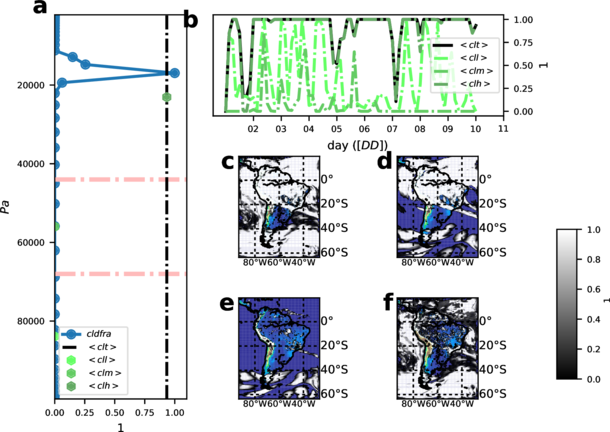
wsgsmax: Maximum Near-Surface Wind Speed of Gust
The wind gust accounts for the wind from upper levels that is projected to the surface due to instability within the boundary layer. It can have different implementations. Winds are Earth-rotated.
-
Brasseur01:An implementation of a wind gust following Turbuelent Kinetic Energy (TKE) estimates and stability by virtual temperature (θv , see mainly equation 1) reproducing Brasseur (2001) from the clWRF ([ http://www.meteo.unican.es/wiki/cordexwrf/SoftwareTools/ClWrf clWRF] Fita et al., 2010) [wsgs_diag = 1]
-
WRF_afwa_diagnostics:Inside the WRF modulemodule_diag_afwa.Fthere is an implementation of the calculation of the wind gust which only occurrs as a blending of upper-level winds (around 1km above ground zagl; -1 zagl(k1000 ) ≥ 1000 m, see equation 2) above a given maximum precipitation inrensity of pratemm_hr ≥ 50 mm [wsgs_diag = 2]
 These two methodologies have been implemented and can be switched by a new
These two methodologies have been implemented and can be switched by a new namelist.input parameter labeled wsgs_diag (in cordex section). Its default value is 1 It comes out, that both methodologies provide wind gust estimation (WGE) from two different perspectives: mechanic and convective. In order to take into account both winds gusts, another variable as the addition of both estimations is provided as totwsgsmax, totugsmax, totvgsmax, totwsgspercen. On figure 2 is shown the different outcomes applying each approximation
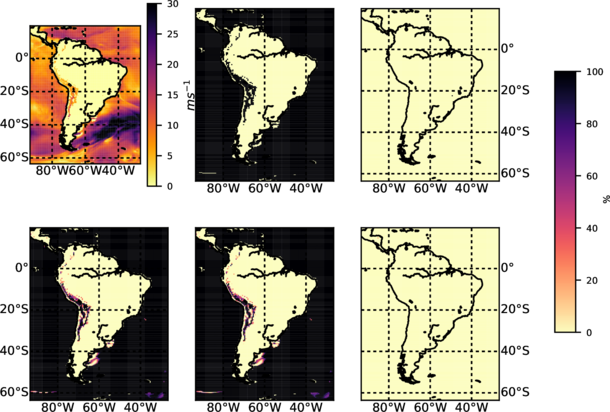
wsgsmax100: Daily Maximum Near-Surface Wind Speed of Gust at 100 m
The wind gust at 100 m is understood that should follow a similar implementation than for the wsgsmax, but at 100 m, since is understood than an extrapolation of such turbulent phenomena it would require a complete new set of equations. This one is let to open discussion. Instead as a way to overcome it, the estimation of maximum wind speed at 100 m is provided. Winds are Earthrotated. After PhD thesis of Jourdier (2015), two different methodologies are implemented to estimate the wind at 100 m above ground:
- Following power-law wind vertical distribution, as it is depicted in equation 3 using the upper-level atmospheric wind speed below (k100) and above (k100) the height above ground of 100 m (zagl) [wsz100_diag = 1]
- Following logarithmic-law wind vertical distribution, as it is depicted in equation 4 using upper-level atmospheric wind speed below (k100) and above (k100) the height above ground of 100 m (zagl) [wsz100_diag = 2]
- Following Monin-Obukhov theory is implemented and was tested, but it is not useful for heights larger than few decameters (z > 80. m). However, the necessary code to extrapolate the wind at given height is left commented just in case someone wants to use it.
These two methodologies have been implemented and can be switched by a new namelist.input parameter labeled wsz100_diag (in cordex section). Its default value is 1. Even one can select another height for the estimation by providing the new parameter z100m_wind with a different value than 100 m (default value)
On figure 3 is shown the different outcomes applying each approximation. There are some problems on MoninObukhov application under certain stable conditions (too small Obukhov length)
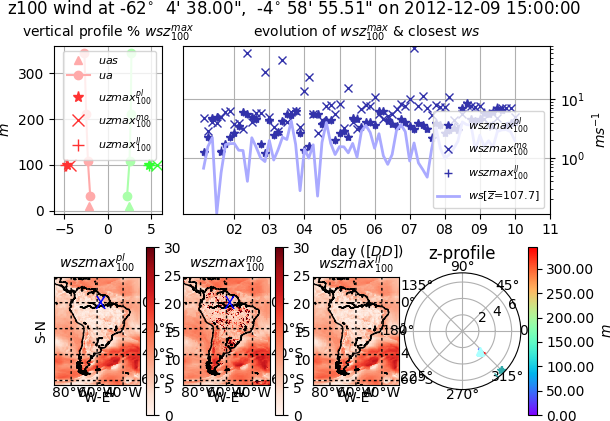
prw: precipitable water or water vapor path
This variable accounts for the column integrated amount of water vapor.
This one is already implemented in a old WRF tool for vertical interpolation called p_interp.F. It was modified by L. Fita when he was as post-doc at the 'Universidad de Cantabria' related to the clWRF. The general equation following WRF standard variables as:
where mu: perturbation dry air mass in column, mub: base-state dry air mass in column, g: gravity, e_vert: total number of vertical levels, qvapor: mixing ratio of water vapour, dnw: full-sigma eta-layer height. See an example on figure 4
clwvi: condensed water path
This variable provides similar information, but for the liquid condensed water species. It is the same calculation as in 5, but replacing QVAPOR by QCLOUD + QRAIN
clivi: ice water path
This variable provides similar information, but for the liquid condensed water species. It is the same calculation as in 5, but replacing QVAPOR by QICE + QSNOW + QGRAUPEL + QHAIL
clgvi: graupel water path
This variable provides similar information, but for the liquid condensed water species. It is the same calculation as in 5, but replacing QVAPOR by QGRAUPEL
clhvi: hail water path
This variable provides similar information, but for the liquid condensed water species. It is the same calculation as in 5, but replacing QVAPOR by QHAIL
psl: sea level pressure
This accounts for the pressure at the sea level (extrapolation of the pressure at the level of the sea). That means the pressure that might be without the presence of orography. Three different methodologies have been implemented
- One using hydrostatic-Shuell method already implemented in the the module
phys/module_diag_afwa.F(assuming a constant lapse-rate of 6.5 K km-1) [psl_diag = 1] - Using smoothed surface pressure and a target upper-level pressure, already implemented in
p_interp.F90[psl_diag = 2] - ECMWF method taken from LMDZ from the module pppmer.F90, following the methodology by Mats Hamrud and Philippe Courtier from ECMWF [psl_diag = 3]
These three methodologies have been implemented and can be switched by a new namelist.input parameter labeled psl_diag (in cordex section). Its default value is 3. Even, on using the 'ptarget' method (psl_diag = 2) one can select the degree of smoothing of the surface place by the selecting the number of times that the smoothing (as the mean of the point and its surrounding 8 neighbors) has to be applied (psmooth, default 5) and the upper pressure to be used as target (ptarget, default 70000 Pa).
On figure 5 is shown the different outcomes applying each approximation. There are some problems with the ptarget methodology in both psl estimate and borders for each parallel process on applying the smoothing
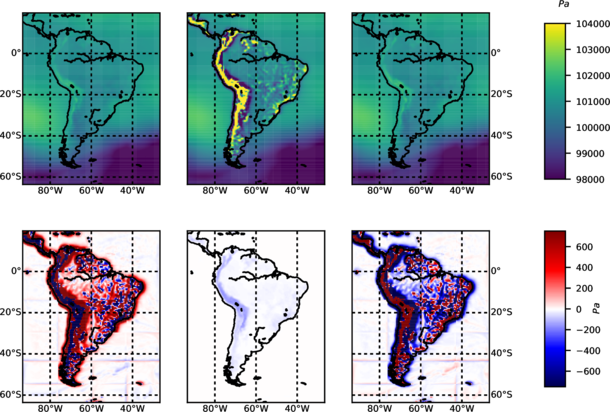
cape: convective available potential energy
This variable accounts for all the energy that convectively might be released. From AMS glossary is described as: (CAPE)
On a thermodynamic diagram this is called positive area and can be seen as the region between the lifted parcel process curve and the environmental sounding, from the parcel’s level of free convection to its level of neutral buoyancy. CAPE may be expressed as follows:
where Tvp is the virtual temperature of a lifted parcel moving upward moist adiabatically from the level of free convection to the level of neutral buoyancy, Tve is the virtual temperature of the environment, Rd is the specific gas constant for dry air, pf is the pressure at the level of free convection, and pn is the pressure at the level of neutral buoyancy. The value depends on whether the moist-adiabatic process is considered to be reversible or irreversible (conventionally irreversible, or a pseudoadiabatic process in which condensed water immediately falls out of the parcel) and whether the latent heat of freezing is considered (conventionally not). It is assumed that the environment is in hydrostatic balance and that the pressure of the parcel is the same as that of the environment. Virtual temperature is used for the parcel and environment to account for the effect of moisture on air density.
It has been at this stage only the calculation already implemented in WRF inside the module module_diag_afwa.F via the function Buoyancy, which at the same time it provides: Convective inhibition (CIN), Height at the Level of free convection (ZLFC), Pressure at the Level of free convection (PLFC) and Lifted index (LI)
cin: convective inhibition
This variable accounts for the process which inhibits the convection. Already provided by the implementation of the AFWA’s CAPE calculation From AMS glossary is described as: CIN)
The energy needed to lift an air parcel upward adiabatically to the lifting condensation level (LCL) and then as a psuedoadiabatic process from the LCL to its level of free convection (LF C). For an air parcel possessing positive CAP E, the CIN represents the negative area on a thermodynamic diagram. The negative area typically arises from the presence of a lid, or the amount of kinetic energy that must be added to a parcel to enable that parcel to reach the LF C. Even though other factors may be favorable for development of convection, if convective inhibition is sufficiently large, deep convection will not form. The convective inhibition is expressed (analogously to CAP E) as follows:
where pi is the pressure at the level at which the parcel originates, pf is the pressure at the LFC, Rd is the specific gas constant for dry air, Tvp is the virtual temperature of the lifted parcel, and Tve is the virtual temperature of the environment. It is assumed that the environment is in hydrostatic balance and that the pressure of the parcel is the same as that of the environment. Virtual temperature is used for the parcel and environment to account for the effect of moisture on air density.
sund: duration of sunshine
This variable accounts for the time where short-wave radiation is above 120 Wm-2 .
It is already implemented in a advance version of the clWRF. See results of the variable in figure 6
hur: relative humidity
Relative humidity can be obtained following the Clausius-Clapeyron formula and its approximation from the AugustRoche-Magnus formula of saturated water vapor pressure es
being tempC: temperature in Celsius degree (◦ C), presshPa: pressure in hPa, es: saturated water vapor pressure, ws: saturated mixing ratio kgkg-1 , q: mixing ratio kgkg-1
hus: specific humidity
From the AMS glossary hus
zg: geopotential height
zg = PH + P HB where PHB, WRF base geopotential height, P, WRF perturbation geopotential height
press: air-pressure
press = P + PB where PB, WRF base pressure, P, WRF perturbation pressure
ta: air-temperature
where T, WRF temperature (which is as potential temperature), PB, WRF base pressure, P, WRF perturbation pressure, p0: pressure reference 100000 Pa
ua/va: air-wind Earth oriented
where Uunstg, unstaggered WRF eastward wind, Vunstg, unstaggered WRF northward wind, COSALPHA, local cosine of map rotation, SINALPHA, local sine of map rotation
cdgen
Drag coefficient at surface. Computation of drag coefficient depends on selected surface scheme. In order to avoid this scheme dependency, a general calculation of the coefficient has been introduced as it is shown in equation 16, after Garratt (1992).
Being, u∗: from similarity theory, wss: 10 m wind speed
tauuv
Surface Downdward wind stress at 10m. It is implemented following the equation 17, begin CD drag coefficient. Winds are Earth-rotated. The generic drag coefficient cdgen is used to compute these variables.
evspsblpot
Potential evapotranspiration is computed following its computation from ORCHIDEE model (Organising Carbon and Hydrology In Dynamic Ecosystems, ORCHIDEE). The implementation is retrieved from the module src_sechiba/enerbil.f90 and basically consists no an implementation of the Penman-Monteith formulation (Monteith, 1965). It is a simple formulation (see equation 18)
where qc: surface drag coefficient, q2sat: Saturated air at 2m (can be assumed to be q2 == qsfc?), uas,vas: 10 m wind components. Up to now there is only one implementation and it is selected via namelist parameter potevap_diag, up to now only with value 1 for the ORCHIDEE implementation
rsus
Surface Upwelling Shortwave Radiation, is understood as the shortwave radiation from land. It is provided accumulated by radiation schemes CAM and RRTMG (sw_ra_scheme = 3,4) in variable swupb. However, it might be re-calculated (if necessary) in a generic way as the reflected shortwave radiation due to albedo as it is shown in equation
rsus = -alebdo ∗ swdown
Being, albedo: albedo, sdown: downward at surface shortwave radiation
rlus
Surface Upwelling Longwave Radiation, is understood as the longwave radiation from land. It is provided accumulated by radiation schemes CAM and RRTMG (sw_ra_scheme = 3,4) in variable slupb. However, it might be re-calculated (if necessary) in a generic way as the longwave radiation due to surface temperature following black body formulation
as it is shown in equation 21
rlus = CtBoltzxman ∗ skt4
Being, CtBoltzman<I>: Boltzman constant, <I>skt: skin temperature
Additional variables
Some other variables not required by CORDEX, but might be interesting for other purposes will be also added
Water vapor balance terms
These covers the different column integrated terms of the water balance equation. The equation of the water vapour budget:
Where q stands for either of the five water species concentration (vapor, snow, ice, rain and liquid), Vh stands for horizontal wind speed, w stands for the vertical wind speed and MP for the loss or gain of water due to cloud microphysical processes. The term in the left-hand side of the equation represents the water species tendency (TEN or PW), referring to the difference between q at the model previous time step and at the end of the actual time step, divided by the time step. TEN equals to the horizontal advection (HOR or 'F', first term in right-hand side of the equation), the vertical advection (VER or 'Z', second term in right-hand side) and the sources (SO) or sink (SI) of atmospheric water due to microphysical processes (MP). All terms are expressed in kgkg-1s-1. However, SO, and SI ca not be provided because they are micro-physics dependent an make difficult to provide a general formula for them.
In order to obtain the total column mass of water due to each term (in units of mm), it is applied to each term of eq. 22 (similarly as in 5):
Following the methodology of Huang et al. (2014) and Yang et al. (2011), Fita and Flaounas (2018) implemented the water budget terms in a new module in WRF in order to allow the computation of the terms during model integration. For the CORDEX module, only the vertically integrated variables will be implemented. Microphysics processes depends on the micro-physics scheme used during model run. It is know the the budget is closed, thus, residual of the terms must be the micor-phsyics term. Due to the complexity of each micro-physics scheme and the impossibility to generalize the calculation, the accumulation of diabatic heating from the micro-physics scheme is provided as a proxy. All water species decomposition is shown in figures 7 and 8 It has also been grouped by vertical levels as it is done with the clouds: p ≥ 68000 P a, 40000 ≤ p < 68000 P a, p < 40000 P a. Decomposition of each term is shown for water vapour qv and snow in figures from 9 to 12.
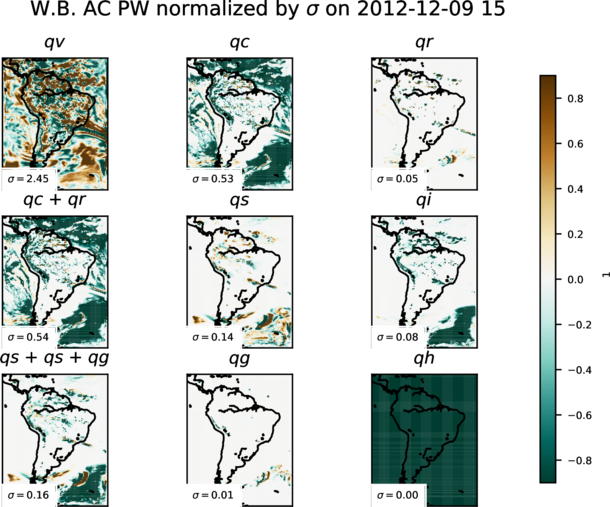
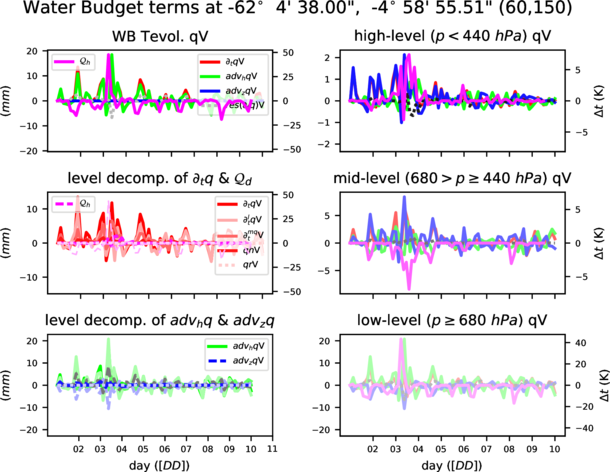
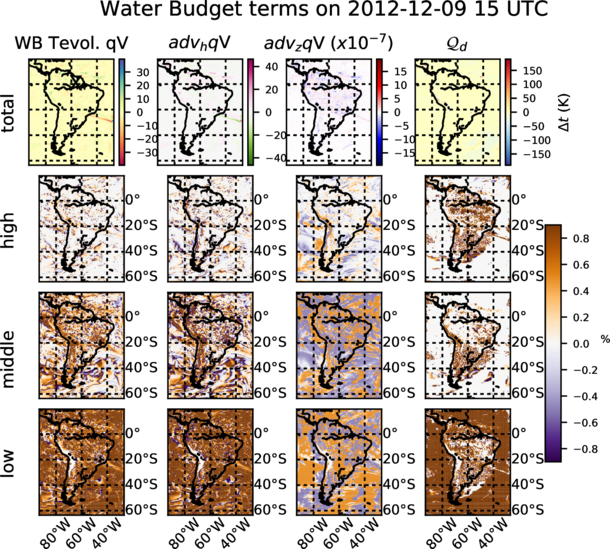
zmlagen: generic boundary layer height
Boundary layer height is a clear example of model dependence and even scheme dependence of how a diagnostic is computed. Each pbl scheme has its own assumptions and has to be compiled in a specific way. However, one could try to find a general definition as it was done in (García-Díez et al., 2013) after (NielsenGammon et al., 2008). The method consists in searching for the first level where potential temperature exceeds the minimum potential temperature reached in the mixed layer (ML) by more than 1.5 K. It has been implemented as it is shown below
- Mixed layer depth (kMLD) first layer at which the variation of mixing ratio upwards from first layer value achieves a given percentage:
- Minimum potential temperature within the MLD: θminM LD = min(θ(1), ..., θ(kM LD ))
- Boundary layer level (kzmla ) first level where: θ(kzmla ) + δθ > θminM LD (here δθ = 1.5 K)
- Boundary layer height (zmla) height above ground (zagl): zmla = zagl(kzmla )
Comparison of this implementation with the zmla directly provided by WRF’s pbl scheme is shown in figure 13.
No general rule has been applied to determine the correct value of δqv used to determine depth of mixed layer. They can be determined by the namelist.input parameters zmlagen_dqv for δqv (default value 0.1) and zmlagen_dtheta for δθ (default value 1.5 K)
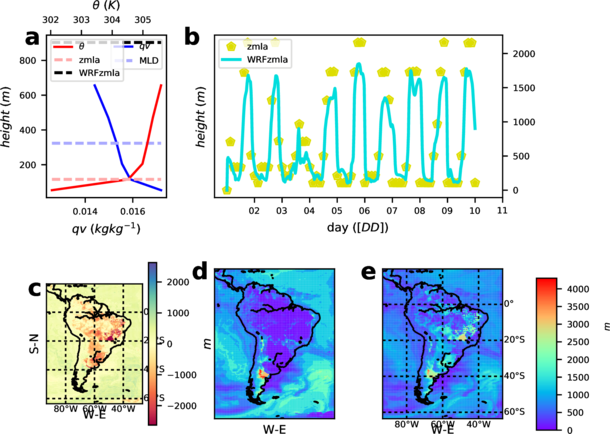
Work done
Following similar experiencies like clWRF, the implementation would be done as follows:
- Introduce the new variables in the
registry.cordex - Reproduce the structure of any of the diagnostics module (e.g.
phys/module_diag_cl.F) and introduce each computation from the different sources. - This accounts for a lot of additional variables, thus all the module related will be activated on computation by a pre-compilation flag called
DIAGCORDEX - Introduction of a new namelis.input section for that variables with more than one option
- Output these variables in a new output file
wrfcdx_d<domain>_<date> - As an additional work, all the instantaneous variables used for the different accumuluations and extremes, can also be retrieved. It is only necessary to:
- Give an output unit on the
registry.cordex(see instructions at the end of the file) - Uncomment in the code (
phys/module_diagnostics_dirver.Fandmodule_diag_cordex.F), the commented lines with the key word:INSTVALS - re-compile WRF
- Give an output unit on the
Missing variables
There are certain variables which could not be introduced (yet?)
wsgsmax100: Daily Maximum Near-Surface Wind Speed of Gust at 100 m
The wind gust at 100 m is understood that should follow a similar implementation than for the wsgsmax, but at 100 m, since is understood than an extrapolation of such turbulent phenomena it would require a complete new set of equations. This one is let to open discussion.
ic_lightning, cg_lightning, tot_lightning: intra-cloud, ground and total lightning flashes
There is lightning scheme implementation in WRF. (lightning_option among other from namelist.input). It might require some adjustment prior it’s use. It does not sees to provide a wolrdwide cloud/ground discrimination
praccmov
Moving accumulated precipitation values for different temporal thresholds (τ ): 30 minutes, 1 hour, 3 hour, 6 hours and 24 hours. This variable might be useful for the impact studies on infrastructures like bridges. The idea would be to provide its maximum between output times (tout ) as it is suggested in the equation 24
Others
It will be some other hard work to do related to it.
New variables
Pretty sure that as we get closer to stake-holders, decision makers, impact and mitigation communities more variables will arise... keep in touch !?
CF-compilant file
WRF does not provide a real CF-compilant file format. It would be necessary to add at least at the output (at least on the wrfcdx_d<domain>_<date> file):
- time variable: CF-version of variable with times in the file
- atrtributes: WRF does not provide variables with standard attributes like: standar_name, long_name, ...
Optimization
Avoid the use of namelist options and got the variables/method directly without the introduction of ifs which might make WRF run slowly. This could be done directly via pre-compilation flags, using for example, the namelist options as pre-compilation options?
Acknowledgements
All the coders of WRF, LMDZ, ORCHIDEE are acknowledged for their work on the developing and maintaining of the models. M. A. Jiménez from Universitat de les Illes Balears (UIB) is acknowledged by her explanations on certain PBL calculations. J. Milovac from U. Hohenheim for her comments is also acknowledged. D. Argüeso from UIB
References
- Brasseur, O. (2001). Development and application of a physical approach to estimating wind gusts. Monthly Weather Review, 129(1):5–25.
- Fita, L., Fernández, J., and García-Díez, M. (2010). Clwrf: Wrf modifications for regional climate simulation under future scenarios. Proceedings of 11th WRF Users’ Workshop.
- Fita, L. and Flaounas, E. (2018). Medicanes as subtropical cyclones: the december 2005 case from the perspective of surface pressure tendency diagnostics and atmospheric water budget. Q. J. Royal Met. Soc., doi: 10.1002/qj.3273
- García-Díez, M., Fernández, J., Fita, L., and Yagüe, C. (2013). Seasonal dependence of wrf model biases and sensitivity to pbl schemes over europe. Q. J. of Roy. Met. Soc., 139:501–514.
- Garratt, J. (1992). The Atmospheric Boundary Layer. Cambridge Univ. Press, Cambridge, U.K.
- Hourdin, F., Musat, I., Bony, S., Braconnot, P., Codron, F., Dufresne, J.-L., Fairhead, L., Filiberti, M.-A., Friedlingstein, P., Grandpeix, J.-Y., Krinner, G., LeVan, P., Li, Z.-X., and Lott, F. (2006). The LMDZ4 general circulation model: climate performance and sensitivity to parametrized physics with emphasis on tropical convection. Clim. Dyn., 27(7-8):787–813.
- Huang, H.-L., Yang, M.-J., and Sui, C.-H. (2014). Water budget and precipitation efficiency of typhoon Morakot (2009). J. Atmos. Sci., 71:112–129.
- Jourdier, B. (2015). Ressource éolienne en france métropolitaine : méthodes dâĂŹévaluation du potentiel, variabilité et tendances. Climatologie: École Doctorale Polytechnique, 2015. Français. ph:+33 01238226, pages 1–229.
- Monteith, J. L. (1965). Evaporation and environment. the state and movement of water in living organisms. 19th Symp. Soc. Exp. Biol, pages 205–234.
- Nielsen-Gammon, J. W., Powell, C. L., Mahoney, M. J., Angevine, W. M., Senff, C., White, A., Berkowitz, C., Doran, C., and Knupp, K. (2008). Multisensor estimation of mixing heights over a coastal city. Journal of Applied Meteorology and Climatology, 47(1):27–43.
- Skamarock, W. C., Klemp, J. B., Dudhia, J., Gill, D. O., Duda, D. M. B. M. G., Huang, X.-Y., Wang, W., and Powers, J. G. (2008). A description of the advanced research wrf version 3. NCAR TECHNICAL NOTE, 475:NCAR/TNÂŋ475+STR.
- Yang, M. J., Braun, S. A., and Chen, D.-S. (2011). Water budget of typhoon nari (2001). Mon. Wather Rev., 139:3809–3828.
